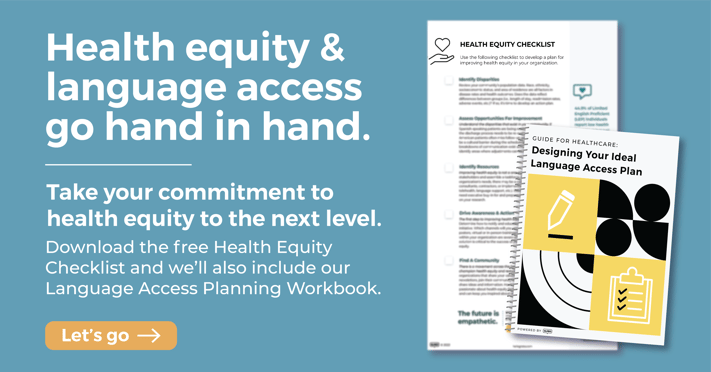Stay up to date.
Stay connected with tips, resources & stories on language access.
Limited-English speakers are particularly vulnerable to negative health outcomes. This makes it harder for these patients to access care and to understand health information that can protect people from contracting and spreading the disease. Cultural beliefs may also hinder a person's ability and willingness to seek care for COVID-19.
To help maintain health equity and ensure better health outcomes for all patients, healthcare providers and public health officials must continue to make language support for LEP populations a priority, especially during a crisis.
There is a lot that we still don't know about the novel coronavirus — commonly known as COVID-19. Even the most knowledgeable healthcare professionals and infectious disease experts are still learning about how the disease and ita new variants spread, how to provide the best care, and the short-term and long-term health effects of contracting COVID.
Now imagine how much more uncertain you would feel if you couldn't understand the information those officials and healthcare providers were releasing about the disease, like how to keep you and your family safe, how to recognize the symptoms, and where to go for care.
In the United States, an estimated 57 million people speak a language other than English at home, and almost 26 million (more than 8% of the population) cannot read, write, or understand English well enough to access essential services like healthcare. The population of LEP individuals is even higher in states with some of the highest COVID-19 cases, including California, New York, Florida, and Texas. The 30 metropolitan areas with the most confirmed COVID-19 cases have an average LEP population of 13.5%, which is 1.6 times higher than the national average.
Research shows that people with limited-English proficiency are more likely to experience negative health outcomes in general, including:
These risks are often directly related to a person's inability to communicate with healthcare providers. Someone with LEP will have more difficulty understanding:
As such, language barriers put these patients at higher risk of complications and death from all sorts of conditions, including COVID-19.
Healthcare organizations have been operating in "crisis mode" since March 2020. But it's important that facilities and providers not let critical services like interpreting slip through the cracks in this chaotic and difficult environment.
All staff and providers in a healthcare facility should be fully trained on how to access language services, how to determine a patient's preferred language, and patients' rights to language services. Staff should also be trained and prepared to gather this information from patients with difficulty breathing or who cannot have caregivers with them due to visitor restrictions in the hospital.
Staff should also be trained on all types of language services so they can offer alternatives to in-person language services when it's appropriate and safe. Look for a language support provider that has options for video remote interpreting (including during telehealth appointments), telephone interpreting, and written translation services that can fill in the gaps when an in-person option is not available or might put patients, providers, or interpreters at risk.
Many LEP patients are not aware of their rights to have a qualified medical interpreter with them during treatment. Some patients may not know to ask, or may not be able to tell you they do not understand English. Healthcare facilities should have written communication translated into multiple languages to let patients know how to request these services. Frequently used communications — including common questions and answers about COVID-19 and signage related to COVID-19 — should be pre-translated into the top languages besides English spoken in your area.
Face masks and other PPE can make it harder to speak and hear, so consider offering technology tools like a tablet or smartphone app to improve communication. However, remember that those tools and other online translation technologies should never be used in the place of a qualified medical interpreter.
Planning ahead is critical in healthcare, especially during a public health emergency. Healthcare facilities must include planning for language support in their overall strategic plans for providing COVID-19 care.
This planning begins with the logistics of how and where you can offer safe and effective translation services. For example, if you need to have someone translate in person, make sure the room is large enough to fit provider(s), patient(s), and an interpreter safely with the ability to maintain social distance. This may require adjusting workflows or protocols to have larger rooms available for LEP patients.
Language services are important at every point in a patient's journey through your healthcare system. They should be available in emergency situations when patients present in the emergency department for critical care services. They should be available in a hospital setting throughout the entire care process from initial admission through discharge. They should also be available in more traditional situations for scheduling, check-in, during the appointment, check-out, and billing.
The COVID-19 pandemic has exposed significant challenges in health equity and our healthcare system, as well as ongoing disparities in access to care for many high-risk populations. Language services can help bridge the gap to keep these patients safe and ensure that they have all the information they need about COVID-19 prevention, vaccines, and treatment in their preferred language.
Download our Special Report on COVID-19 for more information on how you can ensure equitable care to the limited-English speaking community.
